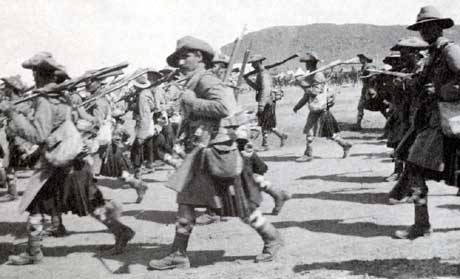
The kilt has a proud history especially in the Highland regiments, however, it also has a dark side. Especially when fighting abroad. During the Boer war 1899 – 1902 Highland soldiers had their legs scraped up by thorns as they struggled through the African bush. You might think to yourself that this shouldn’t be a problem as Highlanders would’ve been used to this kind of thing back in Scotland. But add to this the extreme heat and peelly wally skin tone, the poor lads would’ve been burnt to a crisp. There would be no time to cover their legs from the sun especially when under fire for any length of time. However one man had a clever answer to this problem, a Lieutenant Bertrand from the Argyll and Sutherland Highlanders wore womens stockings when in action. But we won’t judge 😉

When we come to the Great War, with those poor lads in the trenches for weeks at a time sometimes up to their waist in muck their kilts being an ideal nesting ground for lice and other fowl things. The kilt would be sodden and hard the majority of the time and because of this the material could cut quite deeply into the back of the legs. Add to that climbing over numerous obstacles in their bare legs, any cuts and scrapes could cause infections.
The government had always been aware of the problem and had tried several ways to combat it, one idea was to turn worn out kilts into trews, but eventually it was left to the Scots to decide and the majority of Highlanders would rather put up with the discomfort than give up their kilts.
According to declassified documents by the public records office. Scottish troops were involved in a secret plan to wear ladies’ underwear under their kilts on the front line. Don’t worry it’s not as bad as it sounds. From the 1920s – 1939, tests were carried out on volunteer soldiers dressed in long stockings and woollen bloomers, of which had been soaked in protective chemicals dissolved in white spirits, the volunteers were then exposed to mustard gas. These tests were all carried out at Porton Down government research centre in Wiltshire.
Porton Down Historian, Gordon Carter, said ‘a great deal of attention was paid in those days to the impregnation of battledress and socks with substances called impregnities’…. ‘These were chemicals which could actually combine with mustard gas vapours to render them harmless’
The tests showed it to be affective and the first batch of protective underwear were issued to the Argyll and Sutherland Highlanders. There was a little problem, the colour was pink and to make matters even worse they looked very feminine. Let’s just say the report that the Argylls sent back to the war office about their new undergarments was very short and sweet. After this episode, it was decided that it would be far too costly to supply all the Scots regiments with the undergarments and so the kilt was formally banned from the battlefield in 1939. The Camerons were officially the last Highland regiment to wear the kilt as they were still in the field when it was announced but there could’ve been others out there still fighting. There were a few hardened officers and pipers who refused to give up the kilt. There is also a story of a group of highlanders who took part in the raid on St Nazaire on March 28th 1942. They were actually given special permission to wear the kilt. It’s said that it made them more aggressive on the mission.
This is why you only see our Highland regiments in the kilt on special occasions. Although, some Highland regiments still wear a small square of the tartan of their regiment in their bonnets.


Form fitting Buckskin pants under would be like a second tough skin when in Harsh conditions, Brain tanned would be soft and playable and have a Natural look to them at a distance . just saying they have been used for Century’s and are just as manly.
The military heavy kilt was really impracticable in field conditions, wet or dry or desert, despite romantic pictures of kilted clansmen or soldiers striding through the glen, bracken, and heather which are ideal breeding spots for ticks,clegs, and midgies. And in WW1, the mud and trenches made the soldiers life pretty miserable. They were “the Ladies from Hell” living in hell. A wet kilt is not recommended! I once wore mine on a TA expedition and suffered a most miserable evening and night camped @ Arrochar by Loch Lomond, despite anti- midgie cream, fire and tobacco smoke to keep the swarms of the blighters at bay.. Some guys thought going commando made them more macho but a pair of pants might have saved some from bitten legs,backside, and crotch and endless waving and scratching!.
My Mom was a Duncan, her Dad born in Aberdeen. I am confused about he Duncan Clan and the Robertson Clan. Please explain when both clans sure under Donnachaigh, please forgive spelling. My maiden name O’Donnell and I know all the history of RedHugh O’Donnell having been to Ireland 3 times. Would love to visit Scotland and trace my roots. Thank you for any information on these two Scottish Clans.